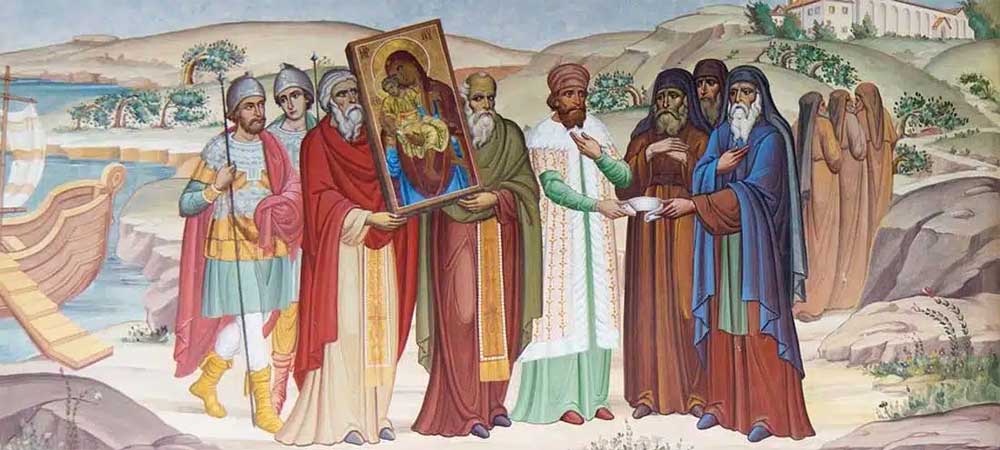Saint Gabriel the Archangel: Messenger of God
 Saint Gabriel was one of the four Archangels, In the Holy Bible, we meet the Archangel Gabriel once in the Old Testament and twice in the New.
Saint Gabriel was one of the four Archangels, In the Holy Bible, we meet the Archangel Gabriel once in the Old Testament and twice in the New.
In the Old Testament, the Archangel Gabriel was the one who appeared to Daniel and interpreted to the prophet the dream of Nebuchadnezzar “enlightening him and adorning the declaration of those who are missing in spirit”, according to the Holy Hymnographer. She explains to him that the ram with the two horns meant the kings of Media and Persia, and the hairy goat, the king of Greece.
Again Gabriel revealed to Daniel, that after seventy years the captivity of the Israelites would last, and after four hundred and ninety-seven years Christ would come.Gabriel was the one who brought the news to Manoe’s wife, that she will give birth to Samson.
And in the New Testament, the Archangel Gabriel was the one who brought the news to Joachim and Anna, that they would give birth to the Lady and Miss Theotokos.
He is the one who brought the news to Zacharias that she will give birth to John the Forerunner and imposes on him, for his unbelief, the penalty of silence until the child is born and named (Luk. 1, 11 et seq.).
Gabriel nourished the Virgin Mary for twelve years in the Holy of Holies with heavenly food.
Gabriel is the Archangel of Evangelism! The Archangel Gabriel brought the joyful news to the Mother of God, that she will give birth to the Son and Word of God from the Holy Spirit.
He appeared in Joseph’s vision and told him not to be afraid, but to take Mary as his wife, because the child he will bear comes from the Holy Spirit.
He also presented himself to the shepherds and brought them the news that the Savior of the world Christ was born.And he in a vision told Joseph to take the Divine Infant and his Mother and flee to Egypt. Again he told Joseph to return to his homeland.
Many scholars and astrologers agree that Gabriel was the Angel who rolled the rock from the monument of Jesus. And he was the one who brought the message to the Myrobearers about the Resurrection of the Lord.
He also presented herself to Our Lady three days before her Dormition and announced to her the decision of her Son to receive her close to him.
In recent years, the Archangel Gabriel appeared to a monk on Mount Athos and in front of the icon of the Virgin Mary he began to chant “Axion Esti”. The monk liked this hymn, but was sad because he would forget it.
Archangel Gabriel, however, engraved the hymn on a marble slab with his finger. Thus the icon of the Virgin Mary was named “Axion Esti” and is kept in Protato, in the central church of Karia on Mount Athos, reminding us that the existence of angels is a reality, as well as the Archangel Gabriel himself.
Archangel Gabriel was the one who ministered the Mystery of the incarnate economy of God’s Word from beginning to end. This is why the Church of Christ decided to celebrate together with the two Archangels Michael and Gabriel, and to invoke their grace and help.
Gabriel was considered one of the Archangels, not only because this is what the ecclesiastical record testifies to, but because he himself had said to the father of the Forerunner, Zacharias, that: “I am Gabriel who stand before God” (Lk. 1, 19).
Already, since the early Christian era, we have pictorial representations of the Archangel Gabriel in sculpture, micro-arts, painting in general, and even on clothes! Until the 4th AD century it was depicted just like the rest of the Holy Angels. Later we meet him in Byzantine frescoes or portable icons more accessible, sweeter and more peaceful than the Archangel Michael. Its form occupies not only arches of the Holy Step, but even parts of the dome! He is depicted alone, next to the Virgin, next to the Pantocrator, together with other Angels, but also in various other phases.
Symbolism and Attributes
Artistically, Saint Gabriel is typically depicted holding a lily, which represents Mary’s purity, or a trumpet, symbolizing the final call on Judgment Day. In iconography, his portrayal with a scroll often signifies his role as a divine messenger.
Theologically, Gabriel’s missions emphasize themes of hope, revelation, and divine intervention. His announcements often involve promises of God’s mercy and the fulfillment of His promises, providing reassurance and guidance to those who receive his messages.
Saint Gabriel is venerated in both the East and the West. He is one of the few angels named in the Bible and is honored for his obedience and faithfulness in serving God’s will. The feast of Saint Gabriel is celebrated on September 29, alongside the other archangels, Michael and Raphael.
In the Eastern Orthodox Church, his feast day is also observed on March 26, the day after the Annunciation, highlighting his role in the momentous announcement to Mary.
Today, Saint Gabriel’s presence is invoked for his protective qualities and his ability to bring good news. People pray to Gabriel for help in communicating effectively, for strength in times of announcement or revelation, and for guidance in understanding their own spiritual visions and dreams.
